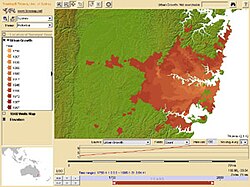|
TimeMap
TimeMap Java is an open-source web mapping application, which was one of the first such applications to introduce generic time filtering and map animation on the web. TMJava is a comprehensive Java mapping applet which can run as a standalone application with local data, on a web site or as a two tier application with a backend server and independent metadata clearinghouse, supporting distributed data sources. TimeMap developed out of work on mapping historical and archaeological data, starting with animated maps in 1995, a Windows mapping tool in 1997, and TMJava from 2001. Funding came from numerous sources but in particular from the Australian Research Council (Sydney TimeMap project, 2000–2002) and from the Electronic Cultural Atlas Initiative (1998–2005). TimeMap is available as open-source on SourceForge.[1] TimeMap's Windows tool, TMWin, is a metadata development and map building tool which will publish interactive maps to a web site using data referenced in the Electronic Cultural Atlas Initiative's metadata clearinghouse.[2] CapabilitiesTMJava can be used to develop interactive maps for web sites, for intranet enquiry systems, for museum and visitor kiosks, and for standalone CD-ROM products. In addition to static datasets, TMJava can connect with databases which are being actively updated or with live data feeds. TMJava has very strong legend and layer management capabilities, easily handling complex maps and large datasets, with incremental loading to deliver increasing levels of detail as one zooms in.[3][4][5] ApplicationsTimeMap's is used as the core technology to number of applications, including:
TMJava provides map-based spatial searching of the ECAI clearinghouse of cultural datasets and background geographic data. The search includes the Rumsey Map Collection, one of the largest digitised collections of historical maps in the world. Search results can be overlaid and displayed in the TMJava map interface, as well as through WMS and Macromedia Flash (.swf) views.[6]
TMJava is used by MacquarieNet's Atlas of Indigenous Australia (free access) and Explore Australia (subscription) interactive maps. Users can display and overlay the many thematic maps of the Atlas.[7][8][9]
A TMJava-based CDROM was developed in 2006 by UNHCR to map refugee resources and refugee camps in Liberia. Poster 2006 by Yann Rebois, UNHCR and CartoONG, Simplified web map version
A TMJava-based CD-ROM accompanying Professor Tony Vinson's important 2004 Community Adversity and Resilience report on behalf of Jesuit Social Services to the NSW and Victorian governments. References
External links |
||||||||||||
Portal di Ensiklopedia Dunia
